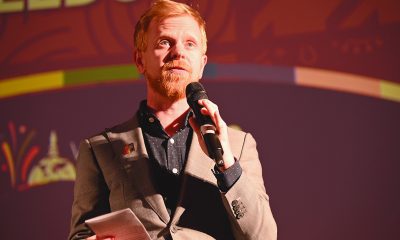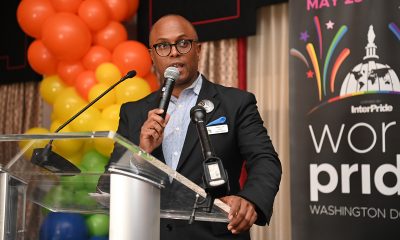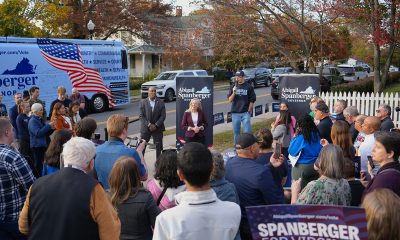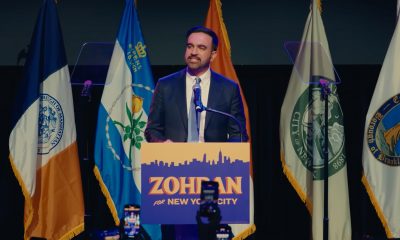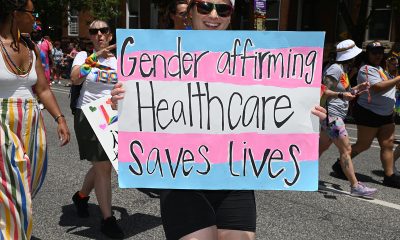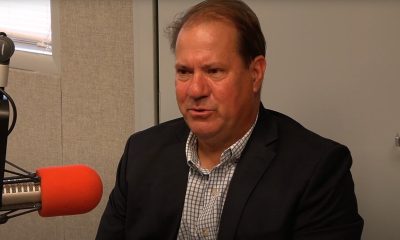Local
Record turnout for Pride
‘Wonderfully diverse’ crowd defies heat, humidity
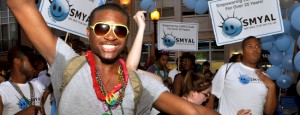
Capital Pride’s parade June 12 featured 175 contingents — the most ever for the event. (Washington Blade photo by Michael Key)
A record-breaking 175 contingents in last weekend’s Capital Pride parade and about 250,000 people at the street festival the next day showed the world how “wonderfully diverse we are as a community,” according to the event’s lead organizer.
Dyana Mason, executive director of Capital Pride Alliance, the non-profit group that organized Washington’s 35th annual LGBT Pride events, called the festivities a “great success.”
“It was wonderfully diverse and had a true cross section of our community,” she said. “It was just wonderful to see everybody from Results Gym to Rainbow Families D.C. to faith communities to the leather contingent. Everybody was there and just being themselves.”
As in past years, the parade’s lead contingent was the lesbian motorcycle group Dykes on Bikes. And a short distance behind them, a contingent of the city’s elected officials joined the parade.
Among them were Mayor Adrian Fenty and his chief rival in the September Democratic primary, City Council Chairman Vincent Gray.
Others included D.C. Congressional Del. Eleanor Holmes Norton and gay D.C. Council members David Catania (I-At Large) and Jim Graham (D-Ward 1), who also are up for re-election this year.
They were joined by Council members Phil Mendelson (D-At Large), Kwame Brown (D-At Large), Jack Evans (D-Ward 2), Mary Cheh (D-Ward 3) and Tommy Wells (D-Ward 6).
Also marching in the parade was former D.C. Parks & Recreation director and gay City Council candidate Clark Ray, who is challenging Mendelson in the September primary.
The politicians, including Fenty and Gray, appeared to be well received as they passed large crowds along a parade route that stretched from 24th and P streets, N.W., around Dupont Circle to the gay enclave along 17th Street.
From there, the parade turned east on P Street, where it passed the official reviewing stand in front of the Whole Foods supermarket near 15th and P streets before ending on 14th Street at Thomas Circle.
The politicians — all of whom are strong supporters of LGBT civil rights — were quickly followed by colorful floats carrying performing drag queens, shirtless male swim team members, gym enthusiasts riding exercise machines, and country western dancers performing the two-step.
Capital Pride officials identified certain contingents as winners of Capital Pride’s annual parade awards: Ziegfeld’s/Secrets nightclub took the Cher Award for Best Theme/Energy; Results Gym captured the Tina Turner Award for Best Float; D.C.’s Different Drummers won the Nancy Sinatra Award for Best Marching Contingent; G Worldwide Resorts earned the Dame Edna Award for Best Visiting Contingent; and Fuego gay bar received the Liberace Award for Most Outrageous.
Also receiving loud applause and cheers along the parade route were the contingents and cars carrying this year’s Capital Pride heroes and super heroes, who were selected for their longtime support for LGBT-related causes.
Among them was Deacon Maccubbin, the former owner of Lambda Rising bookstore who is credited with initiating and organizing the city’s first annual LGBT Pride celebration in 1975.
For many activists, the parade’s route along 17th Street between R and Q streets, N.W., had a special significance this year. On June 10, three days before the parade kick-off, Fenty led a ceremony naming the section of 17th Street between R and Q streets Frank Kameny Way after the nationally recognized D.C. gay civil rights leader.
The ceremony included the unveiling of a newly installed street sign bearing the name Frank Kameny Way, which was visible to parade goers. The street-naming came about through an executive order issued by Fenty.
Kameny, who is credited with founding the city’s gay civil rights movement in the late 1950s, spoke at the ceremony, saying that he could never have predicted the advances in LGBT rights since he was fired in 1957 from his job as a civilian astronomer with the Army Map service because of his sexual orientation.
Joining Fenty in the street naming ceremony was Jack Evans, the Ward 2 Council member whose district includes the newly designated Kameny Way, and gay ANC Commissioner Mike Silverstein, who was among the Dupont Circle ANC commissioners that formally requested the street’s designation.
Also speaking at the ceremony was John Berry, the gay director of the U.S. Office of Personnel Management. Berry noted that OPM’s predecessor agency, the U.S. Civil Service Commission, was the agency that fired Kameny more than 50 years ago for being gay.
“Frank is the perfect storm,” Berry said. “The wall of resistance that he encountered when he challenged his dismissal back in 1957 would have been insurmountable to most people. With no more support than his own brilliant mind and his own powerful lungs, he faced down the United States government.”
Berry noted that over the ensuing decades, Kameny played a key role in guiding the LGBT civil rights movement through battles that ended the government’s ban on civilian gay employees, ended the psychiatric and psychological professions’ classification of homosexuality as a mental disorder, and lifted the government’s ban on issuing security clearances to gay federal employees and contract workers.
“Frank, for every one of us who walk this street, and I walk it daily, your name up here is going to remind us of the power of one person, the power of persistence,” Berry said. “You have changed the world for the better.”
But on the day of the parade, Fenty and other parade goers passing along 17th Street were greeted by another type of sign: professionally printed poster-sized placards bearing the message “Fenty is M.I.A.”
Gay Democratic activist Lane Hudson, who is backing Gray in the mayor’s race, said he and others had the signs made and attached them to light poles along the parade route on 17th Street and along the section of P Street where the parade reviewing stand was located.
Hudson said the placards were intended to deliver a message to parade participants that Fenty has been “missing in action” on a number of LGBT-related issues by not speaking out or meeting with members of the community to address those issues. Anti-LGBT hate crimes, LGBT youth matters and the HIV/AIDS fight were among the issues cited by the signs as issues to which Fenty is not devoting enough attention.
Fenty backers dispute those assertions, though, saying the mayor has extensively addressed those issues during his more than three years in office.
The signs Hudson placed on the light poles list a website for obtaining more information on the subject, but it wasn’t operational earlier this week. Hudson said he planned to activate the site soon.
Capital Pride Alliance President Michael Lutz said the June 13 Capital Pride street festival, held along Pennsylvania Avenue, N.W., between Third and Seventh streets, also appeared to have attracted an unprecedented number of groups, businesses and vendors. Literature released by Capital Pride shows nearly 250 booths lining Pennsylvania Avenue and several side streets.
Among the businesses setting up booths were SunTrust Bank, the Spy Museum, Verizon Wireless, America Online, the New York Times, and the Washington Nationals Baseball Club. Dozens of local and national LGBT organizations also had booths, with many promoting their latest programs and projects.
The intense heat and humidity throughout the day of the street festival was interrupted briefly as rain showers fell for less than five minutes.
Mason credited drag performer Destiny B. Childs with keeping the entertainment going and the crowd pleased from the festival’s main stage during the rain. With the U.S. Capitol as a backdrop looming above the stage, Childs, whose legal name is Richard Legg, staged a show “that was really something to see,” Mason said.
Country western singer Chely Wright, the festival’s headliner performer, closed the program on the main stage to cheering fans. Wright, who came out as lesbian earlier this year in People magazine, recently completed a new album and is promoting an autobiography.
District of Columbia
High cost of living shuts essential workers out, threatens D.C.’s economic stability
City residents don’t always reflect those who keep it running

When Nic Kelly finishes her 6 a.m. shift as a manager at PetSmart, she walks to her bartending job at Alamo Drafthouse in Crystal City to serve cocktails, beers, and milkshakes for hundreds of guests.
Kelly, 26, doesn’t work a combined 60-65 hours per week to pocket extra cash –– she does it to barely make her almost $1,700 rent each month.
“I’m constantly working, and some days I work two jobs in the same day,” Kelly said. “But twice now I’ve had to borrow money from my mother just to make sure I pay my full rent.”
Yesim Sayin, D.C. Policy Center executive director, said this is unfortunately how the D.C. area is structured –– to keep essential workers, service employees, and lower-income people out and those with greater economic mobility in.
The DMV area’s high cost of living makes it near-impossible for employees who keep the area running to make a living, Sayin said. In 2022, only 36% of D.C.’s essential workers lived in the city, according to a D.C. Policy Center report. D.C. is also ranked 13th in the world for highest cost of living as of Nov. 7.
But for Sayin, there’s more work for policymakers to get done than simply acknowledging the high cost of living. Take a look at how current policies are impacting residents, and what long-term solutions could help the DMV thrive.
Feeling the high cost of living
D.C. has the highest unemployment rate in the country at 6.0% as of August. Sayin said the city’s high unemployment rate reflects a lack of geographic mobility in its population, meaning those who can’t find jobs can’t afford to look outside of the DMV area.
Though there are job training groups working to close the unemployment gap, securing a job –– let alone two –– rarely guarantees a comfortable lifestyle for essential and service employees.
A single-person household in D.C. with no children must make at least $25.98 an hour to support themselves, according to the Living Wage Calculator. That number jumps to $51.68 an hour for a single adult with one child. Minimum wage in D.C. is $17.95 an hour and $10 an hour for tipped employees.
Whether it’s utilizing free meals at the Alamo to save on groceries or borrowing money to make rent, every week could bring a different sacrifice for Kelly.
While Kelly lives and works a few minutes south of D.C., Sayin said the connectedness of the DMV means you don’t have to travel far to feel the withering effects of the area’s high cost of living.
“People don’t really care what flag adorns their skies,” Sayin said. “They’re looking for good housing, good schools, cheaper cost of living, and ease of transportation.”
For those that stay in the DMV area, those conditions are hard to come by. This can lead to people working multiple jobs or turning to gigs, such as Uber driving or selling on Etsy, to fill income gaps. Sayin said there are short-term benefits to securing these gigs alongside a primary job, such as helping people weather economic storms, avoid going on government assistance or racking up debt.
But she said the long-term implications of relying on gigs or other jobs can harm someone’s professional aspirations.
“You can spend three extra hours on your own profession every work week, or you can spend three hours driving Uber. One gives you cash, but the other gives you perhaps a different path in your professional life,” Sayin said. “And then 20 years from now, you could be making much more with those additional investments in yourself professionally.”
There’s a strong demand for work in D.C., but when the city starts suffering economically, those who live outside the area –– usually essential or remote workers –– will likely find work elsewhere. Sayin said this negatively impacts those employees’ quality of life, giving them less professional tenure and stability.
D.C.’s cost of living also centralizes power in the city, according to Sayin. When lower-wage employees are priced out, the residents who make up the city don’t always reflect the ones who keep it running.
“Ask your Amazon, Uber or FedEx driver where they live. They’re somewhere in Waldorf. They’re not here,” Sayin said.
Working toward an accessible D.C.
Build more. That’s what Sayin said when thinking of ways to solve D.C.’s affordability crisis.
But it’s not just about building more –– it’s about building smartly and utilizing the space of the city more strategically, Sayin said.
While D.C. has constructed lots of new housing over the years, Sayin noted that they were mostly built in a handful of neighborhoods tailored to middle and upper-class people such as The Wharf. Similarly, building trendy small units to house young professionals moving to the city take up prime real estate from struggling families that have much less geographic mobility, she said.
“The affordability problem is that today’s stock is yesterday’s construction,” Sayin said.
Solving these issues includes ushering in a modern perspective on outdated policies. Sayin cited a D.C. policy that places restrictions on childcare centers built on second floors. Since D.C. parents pay the highest rates in the country for childcare at $47,174 annually, she said loosening unnecessary restrictions could help fuel supply and lower costs for families.
Sayin said policymakers need to consider the economic challenges facing residents today, and whether the incentives and tradeoffs of living in D.C. are valuable enough to keep them in the city.
For Kelly, the incentives and tradeoffs of staying in the DMV area aren’t enough. She’s considered moving back in with her mom a few times given how much she has to work just to get by.
Aside from wanting higher compensation for the work she does –– she noted that businesses can’t operate without employees like her –– Kelly also questioned the value of the tradeoff of moving so close to the city.
“There’s no reason why I’m paying $1,700 for a little studio,” Kelly said. “You also have to pay for parking, utilities aren’t included and a lot of residents have to pay for amenities. We are just giving these property management companies so much money, and we’re not really seeing a whole lot of benefit from it.”
Sayin said placing value on the working people of the city will inject fresh life into D.C.’s economy. Without a valuable tradeoff for living in or around the city, there’s little keeping essential and service employees from staying and doing work taken for granted by policymakers.
District of Columbia
Activist hosts Diwali celebration in D.C.
More than 120 people attended Joshua Patel’s party on Nov. 9.

LGBTQ activist and businessman Joshua Patel hosted a community Diwali party on Nov. 9.
Patel organized the event as a community gathering amid the Trump-Vance administration’s policies against LGBTQ inclusion and DEI. The event, held at the Capo Deli speakeasy, drew more than 120 attendees, including local business leaders.
Patel is a franchise owner of ProMD Health, recently awarded as the best med spa by the Washington Blade. He is also a major gift officer at Lambda Legal.
Patel noted that upon moving from New York to Washington in 2022, he desired a chance for community-based Diwali celebrations. He stated that the city offered minimal chances for gatherings beyond religious institutions, unless one was invited to the White House’s Diwali party.
“With our current administration, that gathering too has ended — where we cannot expect more than Kash Patel and President Trump lighting a ‘diya’ candle on Instagram while simultaneously cutting DEIB funding,” Patel said.
In addition to celebrating the festival of lights and good over evil, Patel saw the event as a moment to showcase “rich, vibrant culture” and “express gratitude.”
Patel coined the celebration a “unifier.”
“From a spiritual angle, Shiva was the world’s first transgender God, taking the form of both “male” and “female” incarnations,” Patel said. “The symbolism of our faith and concepts are universal and allows for all to rejoice in the festivities as much or little as they desire.”
Savor Soiree, DMV Mini Snacks and Capo Deli catered the event. DJ Kush spun music and Elisaz Events decorated the Diwali celebration.
The Diwali party also featured performances by former Miss Maryland Heather Young Schleicher, actor Hariqbal Basi, Patel himself and Salatin Tavakoly and Haseeb Ahsan.
Maryland
Harford school board appeals state’s book ban decision to circuit court
5-2 ruling in response to ‘Flamer’ directive

By KRISTEN GRIFFITH | Marking a historic moment in Maryland’s debate over school library censorship, Harford County’s school board voted Thursday to appeal the state’s unprecedented decision overturning its ban of a young adult graphic novel, pushing the dispute into circuit court.
The 5-2 vote followed a recent ruling from the state board overturning Harford’s ban of the book “Flamer.” In a special meeting Thursday afternoon, board members weighed whether to seek reconsideration or take the matter to circuit court — ultimately opting to appeal.
The book “Flamer” is by Mike Curato, who wrote about his experience being bullied as a kid for being gay.
The rest of this article can be found on the Baltimore Banner’s website.
-

 Politics4 days ago
Politics4 days agoPro-trans candidates triumph despite millions in transphobic ads
-

 Opinions4 days ago
Opinions4 days agoDemocratic Socialism won’t win the whole country
-

 National4 days ago
National4 days agoUS bishops ban gender-affirming care at Catholic hospitals
-

 Maryland5 days ago
Maryland5 days agoSalisbury, Md. rainbow crosswalk removed on Veterans Day



